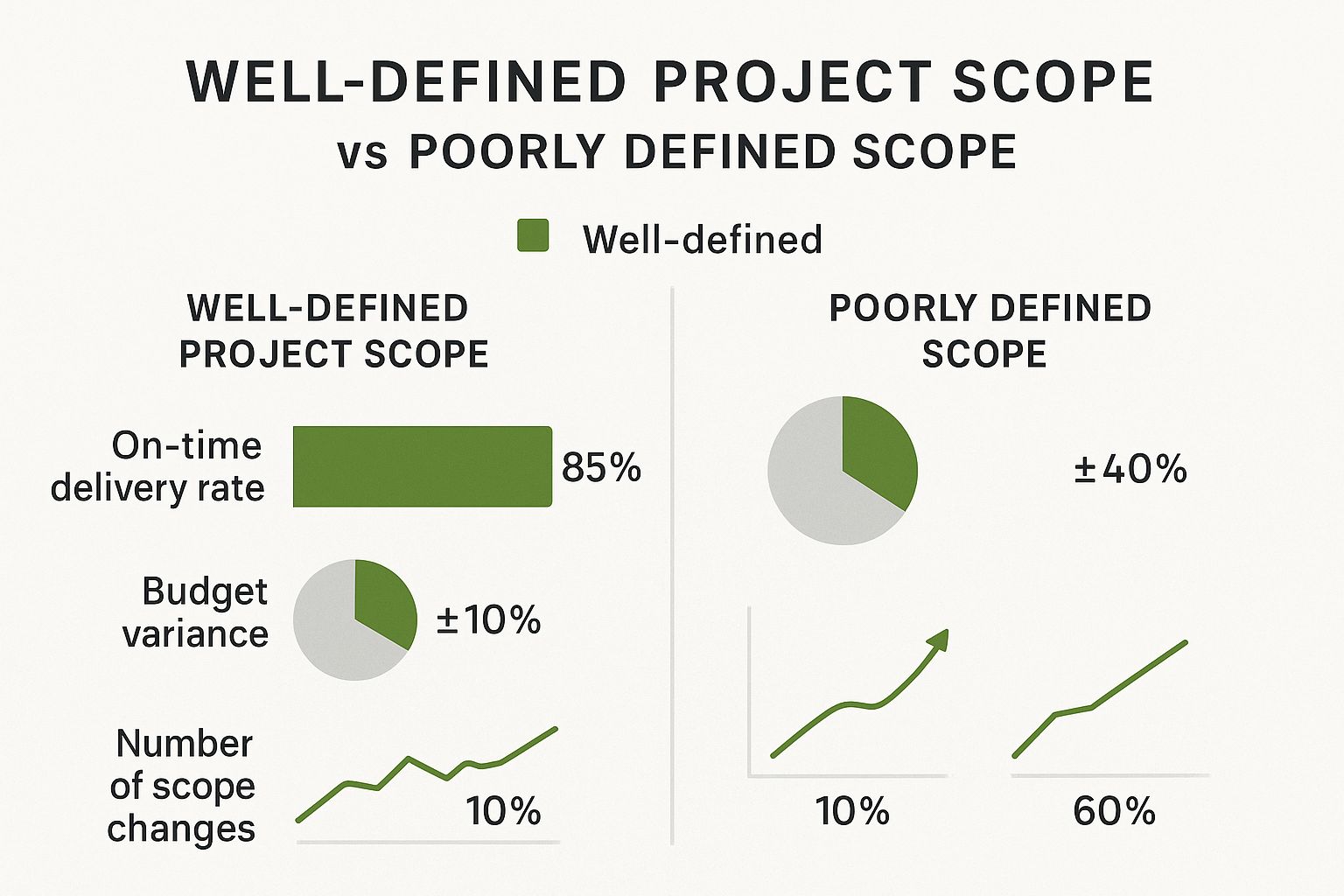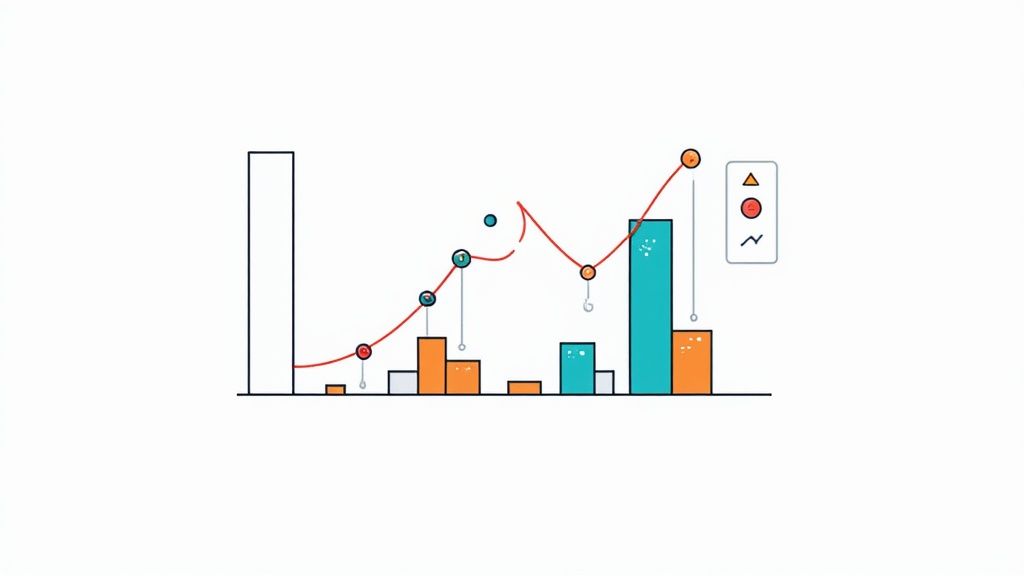Effective Project Management for Agencies | Get Results
Let's be real for a second. The old-school project management playbook just doesn't cut it for a modern agency. You aren't building a bridge with a five-year blueprint. You're juggling a dozen clients, constantly shifting priorities, and a never-ending stream of creative requests. This kind of controlled chaos demands a specific approach to project management for agencies—one that thrives on change while protecting your profits.
Why Your Agency's Project Management Is Broken
Does your daily grind feel less like managing projects and more like trying to land multiple helicopters in a hurricane? If you're nodding along, you’re definitely not alone. This feeling isn't a sign that you have a bad team. It's a symptom of a broken system, one that simply wasn't built for the dynamic, client-focused world agencies live in.
Most traditional project management methods fail because they try to treat creative work like an assembly line. But agency work is anything but predictable; it’s fluid, often subjective, and built on human relationships. When you apply a rigid system to a fluid process, you get a set of recurring problems that slowly chip away at your profits and team morale.
The Profitability Killer: Scope Creep
Scope creep is the classic villain in every agency’s story. It’s sneaky. It starts with a "quick little tweak" here or an "extra social post" there. Next thing you know, your timeline is a mess, the budget is shot, and your team is burning the midnight oil just to keep up.
This isn't just a minor headache; it's a direct hit to your bottom line. Without a rock-solid process for handling change requests, you're basically gambling with every project's profitability. Good agency project management builds a fence around the original scope, with a clear, established process for any changes that want to get through.
A project without a clear scope is like a ship without a rudder. It might be moving, but it has no control over its direction and is likely drifting into costly, time-consuming waters.
Communication Breakdowns Between Teams
Here’s another all-too-common agency problem: the disconnect between departments. Your account team promises the moon, your creative team builds something completely different, and your developers are left scrambling to stitch it all together. Every team has its own priorities and, frankly, speaks its own language.
This siloed way of working creates a domino effect of issues:
- Endless Revisions: Work bounces back and forth because the initial brief was misinterpreted.
- Wasted Time: Designers and copywriters are forced to redo work based on bad or incomplete info.
- Internal Friction: Frustration bubbles up between teams, killing collaboration and making work a drag.
A strong project management system acts like a universal translator. It establishes a single source of truth where everyone, from the client to the creative team, is on the same page about goals, deliverables, and deadlines.
The Unpredictable Nature of Resource Planning
And finally, we have the constant headache of resource planning. Who actually has time to take on that new client project? Is your lead designer completely swamped while a junior dev is twiddling their thumbs? Making educated guesses just isn't a sustainable strategy.
When you don't have a clear picture of your team's capacity, you're essentially flying blind. This guesswork leads directly to burnout for your top performers and leaves others underused. It also makes it impossible to accurately plan for future work, locking you into a cycle of reactive, last-minute decisions that hurt both the quality of your work and your team's sanity. A modern system gives you the visibility to assign people effectively, setting every project up for success from the very beginning.
The Four Pillars of Agency Project Success

If you're tired of running your agency in reactive, chaos-driven mode, it's time to build a solid foundation. This isn't some big secret; it's just a commitment to four core pillars that bring predictability and profitability back into the creative process. Building strong project management for agencies really just means getting these four areas right.
Think of these pillars as the essential supports for your business. If one is weak, the whole structure gets wobbly and is likely to crumble under pressure. But when all four are strong, you create an environment where your team’s creativity and your agency's business goals can both thrive.
1. Proactive Client Leadership
The first pillar is about a mental shift: stop managing clients and start leading them. This doesn’t mean being pushy. It means stepping into the role of the expert partner they hired you to be. It all starts with the kickoff call, where you set crystal-clear expectations for communication, feedback, and what success actually looks like.
This proactive approach puts you in the driver's seat from day one. You don't wait for a client to chase you for an update; you’ve already scheduled a regular reporting cadence. You don’t just hope they understand the scope; you walk them through the Statement of Work (SOW) line by line to get everyone on the same page. This kind of leadership nips misunderstandings in the bud, long before they can derail a project.
2. Ironclad Scope and Budget Guardrails
Scope creep is the silent killer of agency profits. The second pillar is all about building a fortress around your project's scope and budget. This begins with a ridiculously detailed SOW that leaves zero room for interpretation. It must spell out exactly what's included, what's not, and the specific deliverables the client gets.
But a good fence also has a gate, which is where a formal change request system comes in.
- Define the Process: When a client asks for "one more thing," it should automatically trigger a set workflow.
- Assess the Impact: The team evaluates the request's effect on the timeline, budget, and resources.
- Provide a Quote: A formal change order is drafted, outlining the extra cost and time needed.
- Secure Approval: New work only starts after the client signs off on the change order.
This turns those casual "Can you just..." requests into a structured business conversation. It protects your team from doing free work and makes sure every bit of effort is accounted for.
"A change request process isn't a barrier; it's a professional courtesy. It respects the client's new idea enough to give it a proper estimate and respects your agency's time and resources enough to get paid for them."
This strategic view of project management is more important than ever. The global project portfolio management market hit a value of $6.13 billion in 2024 and is on a clear growth trajectory. It shows a massive shift across industries toward tightly aligning project work with core business goals to drive better outcomes.
3. Smart Resource and Capacity Planning
The third pillar is about treating your team's time like what it is: your most valuable, and limited, asset. Guessing who has the bandwidth to take on a new task is a surefire recipe for burnout and inefficiency. Smart resource planning gives you a real-time, data-backed view of your entire team's workload.
This is what lets you make informed decisions. Is your lead designer booked at 110% capacity for the next three weeks? Now you know not to throw another "urgent" task on their plate. Is a junior copywriter only at 40%? That’s a perfect chance for them to shadow a senior or take on a smaller internal project. Proper resource management is the key to a healthy, productive, and sustainable pace for your team.
4. Standardized Workflows and Processes
Finally, the fourth pillar is about creating a repeatable, scalable engine for your agency's operations. You shouldn't be reinventing the wheel with every new project. Standardizing your core processes—from client onboarding and creative briefs to QA and project wrap-ups—is what creates consistency and efficiency.
A standardized workflow acts like a pre-flight checklist, ensuring no critical step gets missed. It makes training new hires a breeze, cuts down on errors, and allows you to accurately predict how long tasks will actually take. A huge part of any successful project is knowing how to measure project success, and standard processes give you the consistent data you need for that. This doesn't kill creativity; it builds a reliable system that frees up your creative team to focus on what they do best.
4. Finding Your Agency’s Project Management Playbook
Picking a project management methodology isn't just about choosing a tool; it's about setting the entire rhythm for how your agency operates. There’s no single "best" way to do things. The right approach really depends on your clients, the kind of work you do, and your team's culture. Getting this right is a huge part of what makes project management for agencies successful.
Think of it like a kitchen. A high-end restaurant that thrives on creativity and last-minute changes runs very differently from a fast-food chain that excels at speed and consistency. Your agency needs to figure out which kitchen model works for you.
Let's break down the most common playbooks to help you find that perfect fit.
The Architect's Blueprint: The Waterfall Method
Waterfall is the old-school, traditional approach. It's completely linear, meaning you have to finish one phase of the project before you can even think about starting the next. It’s like building a house from a detailed blueprint—you lay the foundation, then the frame, then the roof. You can't just decide to put up the walls before the foundation is poured.
This method is a rock-solid choice for projects where the scope, deliverables, and deadlines are crystal clear from day one.
- Best For: Standard five-page website builds, brand logo packages, or one-off print campaigns. Basically, any project with a fixed outcome and very little room for surprises.
- Agency Pros: It gives clients and teams total clarity. Everyone knows exactly what’s happening and when. This makes budgeting and setting timelines incredibly straightforward.
- Agency Cons: The biggest downside is its rigidity. If a client wants to make a big change halfway through, it can throw the whole project off track. Going back to adjust the "blueprint" is often frustrating and expensive.
The Chef's Recipe: Agile Methodologies
Agile isn't so much a strict process as it is a mindset built on flexibility, collaboration, and being able to react to change. Instead of one massive launch, you break the project into small, bite-sized cycles called "sprints" or manage it in a continuous flow. It’s like a chef constantly tasting and adjusting a sauce while it simmers, not just following a recipe blindly and hoping for the best at the end.
This is especially important when you don't have all the answers upfront. The infographic below shows just how much a well-defined scope—common in Waterfall projects—can impact success compared to a poorly defined one.

The data speaks for itself. Projects with a well-defined scope hit their deadlines 85% of the time, while that number plummets to just 50% for poorly defined scopes. Agile is designed to tackle exactly this kind of uncertainty.
Within the Agile family, two frameworks are especially popular for agencies:
Scrum: This is a more structured flavor of Agile that runs in fixed-length sprints, usually lasting 2-4 weeks. Each sprint has a clear goal, and the team pulls tasks from a backlog to complete. It’s a fantastic fit for complex marketing campaigns or web development projects with lots of moving parts.
Kanban: This is a highly visual and fluid system that’s all about continuous flow. Tasks move across a board from a "To-Do" column to "In Progress" and finally to "Done." It's less rigid than Scrum and perfect for teams handling a constant stream of requests, like social media or content teams. This kind of work has its own challenges, and you can learn more in our guide to master project management for social media.
Agency Project Management Methodologies Compared
Choosing between these isn't always easy. Each has clear strengths and weaknesses depending on your agency's needs. This table breaks down the core differences to help you see which one might be the best fit.
| Methodology | Best For | Pros for Agencies | Cons for Agencies |
|---|---|---|---|
| Waterfall | Simple projects with a fixed scope, clear deliverables, and firm deadlines. | Easy to plan and budget. Provides clarity for clients. Predictable timelines. | Very rigid and resistant to change. A single delay can disrupt the entire schedule. |
| Agile (Scrum) | Complex, long-term projects with evolving requirements, like app development. | Highly adaptive. Encourages client collaboration. Delivers value in small increments. | Can be complex to implement. Risk of scope creep without a strong Product Owner. |
| Agile (Kanban) | Teams with a continuous workflow and varying priorities, like content or support. | Extremely flexible. Visualizes workflow. Limits work-in-progress to prevent burnout. | Can lack the time-bound urgency of Scrum. May not be ideal for large, defined projects. |
| Hybrid | Most agency projects that require upfront planning but internal flexibility. | Balances client need for certainty with creative team's need for agility. | Requires careful management to blend two different mindsets effectively. |
Ultimately, the best approach is the one that helps your team deliver amazing work without burning out. Many agencies find that a mix-and-match approach works best.
The Best of Both Worlds: The Hybrid Approach
For many agencies, going all-in on Waterfall or Agile feels like trying to fit a square peg in a round hole. That's where the Hybrid model comes in. As the name implies, it borrows the best elements from both. You might use a Waterfall approach for the initial discovery and planning phase to give the client a solid scope, budget, and timeline.
The Hybrid model gives you the best of both worlds: the upfront clarity clients appreciate (from Waterfall) and the internal flexibility your creative team needs to do their best work (from Agile).
Once the project is greenlit, the internal team can switch to an Agile workflow. This lets them iterate, adapt, and collaborate freely within the bigger structure you already established.
For instance, a major website redesign could start with a Waterfall-style contract and high-level timeline. But the actual design and development work could be managed in two-week Agile sprints, allowing for regular check-ins and adjustments without blowing up the budget. It’s a powerful balance that gives modern agencies the structure they need to stay profitable and the freedom they need to be creative.
Using Technology to Streamline Agency Operations

A great process without the right tools is like having a brilliant recipe but no kitchen to cook in. You can map out the world's best project management methodology on a whiteboard, but it’s just a theory until technology brings it to life. For any modern agency, project management software is the engine that turns good ideas into tangible, profitable work.
These platforms are so much more than glorified to-do lists. Think of them as the central nervous system for your agency—a single source of truth that keeps your creative geniuses, account managers, and leadership teams all on the same page.
Beyond Basic Task Management
True project management for agencies demands software that gives you a complete picture of your operations. It’s not just about ticking off tasks; it’s about understanding the people, time, and money tied to every single one. This is what helps your team get ahead of problems instead of constantly reacting to them.
Instead of the endless "Who's handling this?" questions, you can see your team's entire workload at a glance. This means you can assign work intelligently, prevent your best people from burning out, and make sure everyone is pulling their weight. When looking at different tech solutions, you might find it helpful to see what platforms like the one on the Makerbox homepage offer as a point of comparison.
Must-Have Features for Agency PM Software
When you're shopping for a platform, a few core features are non-negotiable for the fast-paced agency world. These are the functions that separate a simple task tracker from a true operational hub.
- Centralized Task and Project Views: You need one place to see everything, with the ability to filter by client, team member, or deadline. It’s all about clarity.
- Real-Time Collaboration: Features like in-task comments, file sharing, and team mentions kill confusing email threads and scattered Slack DMs.
- Time Tracking and Budgeting: Built-in time tracking is crucial for knowing if a project is actually making you money. You have to see how your estimated hours compare to reality.
- Resource Management: This gives you a visual way to see who has room for more work and who is swamped. It's the key to planning ahead and protecting your team.
This reliance on tech is a massive industry trend. The project management software market is expected to jump from an estimated $7.24 billion in 2025 to over $12 billion by 2030. It’s no wonder, considering that around 82% of companies now use these tools to get more done.
Driving Profitability with Reporting and Dashboards
Ultimately, any system you implement should help your bottom line. This is where modern project management software really shines, thanks to powerful reporting and analytics dashboards that give you the data to make smarter business decisions.
A project management tool's greatest value isn't just organization; it's illumination. It shines a light on project profitability, team utilization, and scope creep, turning gut feelings into hard data you can act on.
Imagine being able to instantly see which types of projects are your most profitable or which clients always seem to need the most revisions. This information is gold. It helps you write better proposals, adjust your pricing, and focus your energy on the kind of work that truly grows your agency. It transforms project management from a necessary chore into a real strategic advantage.
The final piece of the puzzle is seamless integrations. Your PM tool needs to play nicely with the other software you use every day, like accounting platforms, CRMs, or specialized creative tools. For example, connecting to schedulers can create a perfectly unified workflow, a topic we dive into in our review of the top social media management tools for 2025. This kind of connectivity ensures information flows smoothly across your entire business.
Here’s a look at some practical, road-tested ways to keep your projects from going off the rails.
Knowing which project management methodology to use is one thing. Actually putting it into practice when a deadline is breathing down your neck is another beast entirely. When the pressure is on and clients are getting antsy, even the most carefully crafted plans can start to unravel. This part of the guide is your field manual for stopping those common agency disasters before they even start.
Think of this as your "do this, not that" cheat sheet for the most critical project moments. It’s all about turning theory into real-world habits that shield your team, your bottom line, and your client relationships. And these proactive steps really matter—the cost of getting it wrong is higher than you might think.
Even with all our modern tools, organizations still waste about 12% of their resources because of poor project management. On top of that, a whopping 91% of project managers say they face major challenges inside their companies, which tells you just how common these problems are.
Run Kickoff Meetings That Actually Work
The project kickoff meeting isn't just a box to check; it’s your first, best shot at preventing chaos down the line. A bad kickoff is fuzzy and leaves everyone walking away with their own version of the plan. A great kickoff gets everyone on the same page from day one.
To pull that off, your agenda needs to be sharp and to the point:
- Define Success: Go deeper than just "we need a new website." Ask the client, "What does a successful outcome look like for your business six months from now?" This gets everyone focused on the real business goal.
- Clarify Roles: Nail down the single point of contact on the client's team who has the final say on approvals and feedback. This one step can save you from a world of conflicting instructions later.
- Set Communication Rules: Agree on everything from response times to how often you'll meet and where updates will be posted. This simple act is key to improving team communication and keeping things running smoothly.
A project kickoff is not a presentation; it's an alignment session. The goal isn't to talk at the client, but to build a shared understanding of the road ahead, complete with guardrails and milestones.
Write a Statement of Work That Protects You
Your Statement of Work (SOW) is your most powerful weapon against scope creep. A vague SOW is basically an open invitation for clients to ask for "just one more thing" without expecting to pay for it. A rock-solid SOW draws clear lines in the sand, defining exactly what the project is—and what it isn't.
A truly bulletproof SOW includes:
- Specific Deliverables: Don't just say "social media assets." Get specific: "12 static Instagram posts (1080x1080px) and 4 short-form videos (9:16 aspect ratio)."
- What's Not Included: Explicitly state what's out of scope. For example, you might add, "This SOW does not cover paid ad spend management or community engagement."
- The Revision Process: Clearly define how many rounds of revisions are included and what the difference is between a "revision" and a "change request."
This level of detail is a huge part of setting clear expectations from the start and making sure you get paid for all your hard work. For more on this, check out our guide on how to manage client expectations.
Establish a Single Source of Truth
Communication chaos is a classic agency nightmare. Important info gets buried in endless email chains, conflicting Slack messages, and notes from a meeting someone forgot to share. This mess leads directly to missed deadlines and frustrating rework.
The fix is simple: create a "single source of truth." This is one central hub—usually your project management software—where every single piece of project information lives. When everyone knows exactly where to find the latest brief, feedback, and approved files, confusion disappears. Your team can finally work with confidence, which can completely transform your project management for agencies.
Answering Your Agency Project Management Questions

Even with the best strategy laid out, theory only gets you so far. The real test comes when you start putting new processes into practice, and that's when the specific, nitty-gritty questions always pop up. Making the switch to a more structured approach to project management for agencies can feel like a big leap, and it often unearths some unique challenges.
This section is all about tackling those common questions we hear from agency leaders all the time. We'll give you straight, practical answers to help you navigate the tricky parts—like protecting creativity while hitting deadlines, getting your team to actually use a new system, and measuring what really matters.
What Is the Biggest Project Management Challenge for a Creative Agency?
Hands down, the single biggest challenge is the constant tug-of-war between creative freedom and the cold, hard realities of budgets and deadlines. Creatives thrive when they have the space to explore, experiment, and come up with brilliant ideas. But at the end of the day, every project has to ship on time and make money for the agency. It’s a tough balancing act.
A truly great agency project manager isn’t just a taskmaster cracking a whip. They’re an architect, building a framework that protects both the creative process and the agency's bottom line. They do this by creating structure around the creativity—things like dedicated brainstorming sessions or super clear feedback loops—while keeping a firm hand on the project’s schedule and budget.
The goal isn't to box creativity in. It's to build a profitable container for it to flourish. This is how you ensure that amazing work also hits client goals and keeps the lights on, turning great ideas into successful, billable outcomes.
How Do I Get My Team to Actually Use a New PM Process?
If you think you can just fire off a memo announcing a new tool and expect everyone to jump on board, you’re in for a rough time. Real, lasting change is about people, not just software. You have to earn their buy-in; you can’t just demand their compliance.
Start by explaining the “why” behind the change. Get specific. How will this new process solve the headaches they deal with every single day? Think confusing feedback chains, last-minute fire drills, or work bleeding into their weekends. When your team sees how a new system makes their lives easier, they’ll be far more willing to give it a real shot.
From there, it’s all about a smart rollout.
- Involve Them From the Start: Don't just pick a tool and force it on them. Bring key team members into the evaluation process. Let them have a say in customizing the setup so it fits the way they genuinely work.
- Start Small: Don't go big bang. Launch the new process with a single pilot project. This creates a low-stakes sandbox where you can iron out the kinks and get honest feedback without derailing the entire agency.
- Lead From the Top: This is non-negotiable. If the agency partners and directors are using the new system for their own tasks and communication, it sends a crystal-clear message. It shows this isn't just another flavor-of-the-month idea—it's the new standard for how things get done.
What KPIs Should We Track for Agency Project Success?
To get a real sense of a project's health, you have to look beyond just "on time" and "on budget." Those are table stakes. They’re important, but they don't paint the full picture of success. The best agencies track a handful of Key Performance Indicators (KPIs) that give them a complete, 360-degree view.
Think of it like the dashboard in your car. The speedometer is crucial, but you wouldn’t drive cross-country without also checking the fuel gauge, engine temperature, and oil light.
Here are the essential KPIs every agency should have on their dashboard:
Project Profitability: This is the ultimate truth-teller. Once you account for every hour your team spent (at their internal cost rate) and all the hard costs, did you actually make money? A project can be a creative masterpiece that the client loves, but if it cost more to produce than you billed, it was a financial loss.
Resource Utilization: This metric shows you how much of your team's available time is spent on billable client work. A healthy target is usually around 75-85%. If it's too low, you’ve got people on the bench. If it's consistently too high, you’re on a fast track to burnout.
Client Satisfaction: Don't just guess if your clients are happy—ask them. A simple Net Promoter Score (NPS) survey after a project wraps is an incredibly valuable tool. Just asking, "How likely are you to recommend our agency to a friend or colleague?" can reveal a ton about the client experience.
Scope Creep: This is a powerful diagnostic. Track the number of out-of-scope requests or change orders that come up on each project. If you see a high number, it’s a flashing red light that you need to tighten up your initial scoping process and kickoff meetings.
Ready to take control of your agency’s projects and creative workflows? With Publora, you can centralize your entire content pipeline, from planning and AI-assisted creation to scheduling and client approvals, all in one intuitive dashboard. Stop the chaos and start delivering results. Explore how Publora can transform your agency’s efficiency by visiting https://publora.com.
